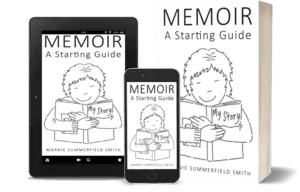
I just read Lidia Yuknavitch’s memoir The Chronology of Water. I’ll write more about it soon as I’m still digesting but WOW. Incredible writing, fascinating structure and form. That is one courageous and fearless (adult) memoir!
In it, she mentions how Virginia Woolf wrote, “arrange whatever pieces come your way.” Woolf was offering wisdom about navigating life’s unpredictability. But this philosophy applies beautifully to the art of memoir writing as well.
Memoir writing isn’t a linear process. It rarely begins with “I was born on…” and proceeds chronologically through life’s events. Instead, memories surface as fragments – a childhood scene of a special toy, your mother’s voice in the car, the feeling of a significant moment while drifting to sleep.
These spontaneous recollections are gifts. They emerge because they hold significance, even when we don’t immediately understand why. Trust these fragments. When a memory presents itself with emotional weight or vivid detail, it’s signaling its importance to your story.
Rather than forcing a predetermined narrative structure, try gathering these pieces as they come. Write them down without judgment. Some might be just a sentence, others several pages. Don’t worry about where they fit yet. Simply collect them.

The beauty of memoir writing lies in the arrangement stage. Like a mosaic artist, you’ll begin to see patterns and connections between seemingly disparate memories. One fragment illuminates another. Themes emerge organically when you trust this process.
This approach honours the authentic nature of memory itself—nonlinear, associative, and emotionally driven. By arranging pieces as they come to you, your memoir will reflect how memory actually works in the human mind.
Many memoirs employ this mosaic (or patchwork) structure. They trust readers to follow emotional rather than strictly chronological threads. They embrace the gaps between memories as spaces where meaning can flourish.
So keep a notebook or the recording app on your ‘phone handy. Record memory fragments when they appear. Trust that your subconscious is offering exactly what you need in that moment. Later, spread your fragments out – literally on a table if it helps – and begin the fascinating work of arrangement.
Remember Woolf’s wisdom: the pieces that come your way are precisely the ones you need. Arrange them with care, and your authentic story will emerge.
Not as a perfectly ordered timeline, but as a truthful reflection of a life as it was actually experienced and remembered.
